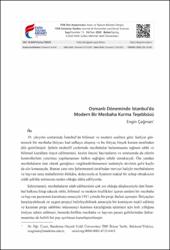Osmanlı Döneminde İstanbul’da Modern Bir Mezbaha Kurma Teşebbüsü
Citation
ÇAĞMAN, Engin. "Osmanlı Döneminde İstanbul’da Modern Bir Mezbaha Kurma Teşebbüsü." FSM İlmî Araştırmalar İnsan ve Toplum Bilimleri Dergisi, 15 (2020): 33-62.Abstract
19. yüzyılın sonlarında İstanbul’da bilimsel ve modern usullere göre faaliyet gösterecek
bir mezbaha ihtiyacı had safhaya ulaşmış ve bu ihtiyaç birçok kurum tarafından
dile getirilmiştir. Şehrin muhtelif yerlerinde mezbahalar bulunmasına rağmen sıhhi ve
bilimsel kurallara riayet edilmemesi, kesim öncesi hayvanların ve sonrasında da etlerin
kontrollerinin yeterince yapılamaması halkın sağlığını tehdit etmekteydi. Öte yandan
mezbahaların tam olarak gereğince vergilendirilememesi nedeniyle devletin gelir kaybı
da söz konusuydu. Bunun yanı sıra Şehremaneti tarafından mevcut haliyle mezbahaların
ve hayvan satış mahallerinin ihtikâra, dolayısıyla et fiyatının makul bir sebep olmaksızın
ciddi şekilde artmasına neden olduğu iddia ediliyordu.
Şehremaneti, mezbahaların ıslah edilmesinin çok zor olduğu düşüncesiyle tüm İstanbul
halkına hitap edecek sıhhi, bilimsel ve modern özellikleri içeren umûmi bir mezbaha
ve hayvan pazarının kurulması amacıyla 1911 yılında bir proje ihalesi açmıştır. İhtiyaçları
karşılayabilecek en uygun projeyi belirleyebilmek amacıyla bir komisyon teşkil edilmiş
ve kazanan proje sahibine müesseseyi kurması karşılığında işletmesi için kırk yıllığına
imtiyaz tahsis edilmesi, bununla birlikte mezbaha ve hayvan pazarı gelirlerinden Şehremanetine
de belirli bir pay ayrılması kararlaştırılmıştır.Makale, Osmanlı arşiv belgeleri üzerinden söz konusu mezbaha ve hayvan pazarı
tesisi kurma çabalarını ele almaktadır. Böyle bir tesis ihtiyacının ortaya çıkış nedenleri,
ihaleyle ilgili hazırlanan raporlar, ihaleye karşı gösterilen tepkiler, devlet kurumlarının
ve sektör temsilcilerinin meseleye yaklaşımı birinci el kaynaklardan faydalanarak ortaya
koyulmaya çalışılmıştır. In Istanbul, the need for a slaughterhouse operating under scientific and modern methods
reached its peak toward the end of the 19th century, leading numerous institutions to
address such demand. Although there were already established slaughterhouses in various
locations of the city at the time, the public health was in jeopardy as medical and scientific
principles were not followed, and no pre or post-slaughter inspections of animals were
carried out. Moreover, these slaughterhouses were not subject to appropriate taxes, resulting
in government revenue loss. Furthermore, the “Şehremaneti” (Municipality) claimed
that the slaughterhouses and livestock markets in their current form were generating unfair
profits, causing the meat prices to spike without any precedence.
Considering the reformation of current slaughterhouses a grueling task, the Şehremaneti
launched a tender in 1911 for the construction of a public slaughterhouse and livestock
market equipped with all the medical, scientific, and modern standards for use of all
the inhabitants of Istanbul. A commission was appointed to determine the most suitable
project and it was decided to grant the operating rights of the establishment for 40 years
to the winning project in return for the construction of such establishment, as well as to
allocate a certain share to the Şehremaneti from the revenues of the slaughterhouse and
the livestock market.
The present paper examines the efforts undertaken to build a slaughterhouse and a
livestock market using Ottoman archival documents. The causes of the demand for such
an establishment, the reports on the tender process, the reactions against the tender, and
government institutions and industry leaders’ approach on the issue were identified through
first-hand sources.



















